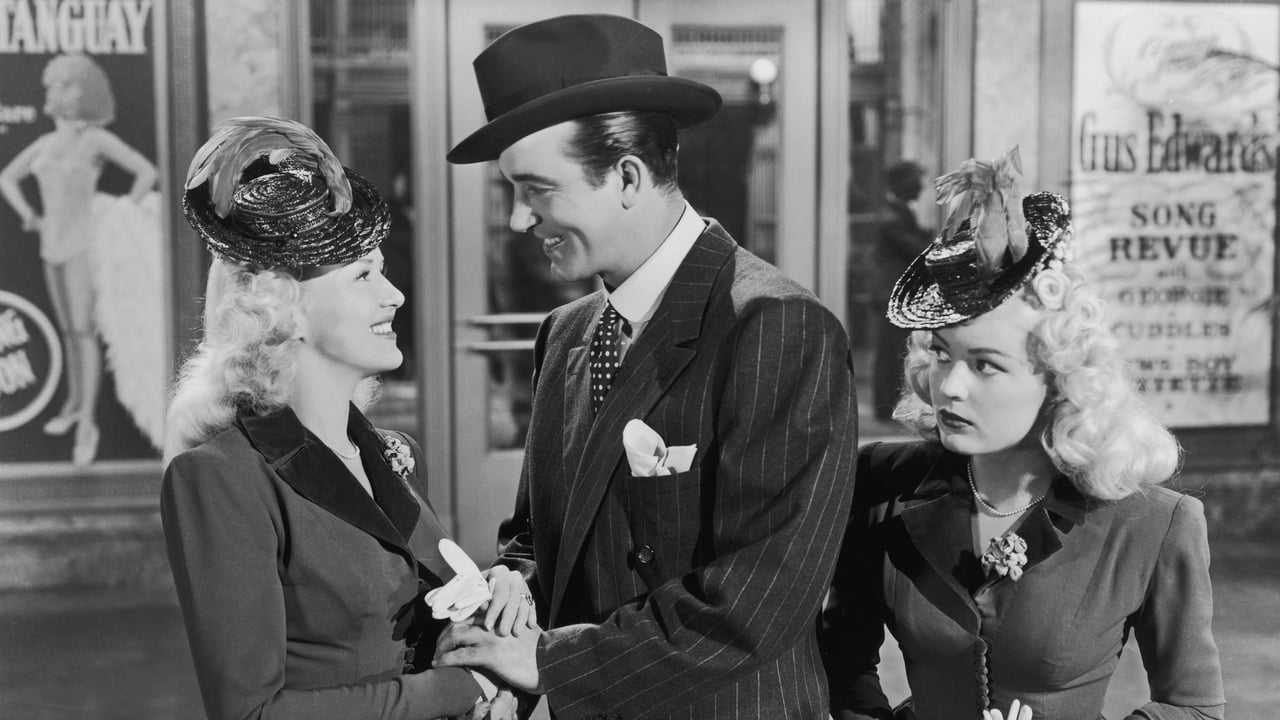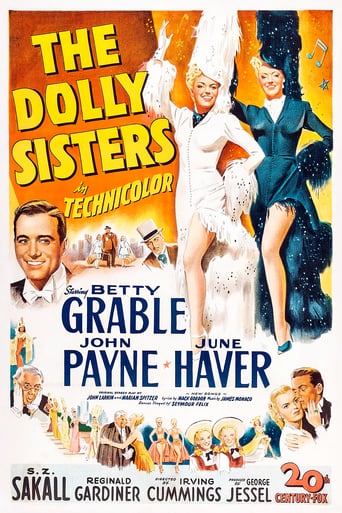

I realize that the years pass and we all get older, but by film's end Betty Grable looked like an old has-been up against John Payne who aged properly for film purposes.This being said, we have an endearing fictional biography of the Dolly Sisters who made it so big in revue's and vaudeville in the 1900s, but their devotion to each other just about wrecked Grable's relations with her husband, Harry Fox, played amicably by John Payne, who belts out I'm Always Chasing Rainbows and ditties with pleasure.How come June Haver, as the other sister, never ages in the film?The music and dancing here are wonderful and the story line, though so familiar in Hollywood land, is done well.As the uncle, S.Z. Sakall is given little to do here and doesn't do his usual fracturing of the English language.With that feel good ending, the beautiful set decorations just add to this tuneful rendition.
... View MoreThe Dolly Sisters is another of those nostalgic biographical film salutes to a pair of twin sisters from Hungary who became celebrated entertainers in those years before World War I and the Roaring Twenties. Both sisters had a few marriages and suffered many ups and downs in their lives. Of course this being Hollywood we're getting quite a sanitized version of them.They were in fact identical twins, but 20th Century Fox did not decide to cast one actress in both roles. Originally it was supposed to be Alice Faye and Betty Grable, but Alice took her screen retirement when Darryl Zanuck would not give her more dramatic roles and June Haver was brought in to replace. Both Grable and Haver had their hair done in the same style, wore the same outfits all the time and my guess was that Haver who was slightly smaller wore platforms to give her equal height or almost equal height with Grable.A lot of interpolated period music is used, but Jimmy Monaco and Mack Gordon wrote one original song I Can't Begin To Tell You which was nominated for an Oscar. It also has the unique distinction of being the only song Betty Grable commercially recorded during her stint at Fox because Zanuck did not like his stars singing for records. She did a vocal with her husband Harry James's band under a pseudonym at the time. Later releases credit Betty. But the big selling record of this song was by Bing Crosby with only a piano accompaniment by Carmen Cavallaro. It was one of Bing's biggest sellers. It's sung at various times in the film by Betty, June and John Payne and a few combinations thereof.John Payne plays Harry Fox, song and dance man who Grable marries and leaves. In real life they never got back together which is what the film alludes to. Also it shows Fox as being jealous of the success of the sisters. In fact he was a success before they were and Jenny Dolly was accused of marrying him to boost her career. In fact that was an accusation leveled at both sisters who made a few advantageous matches.In real life there was no happy ending for Jenny Dolly, she committed suicide in 1941, she was in a lot of pain and never recovered from the automobile accident that Betty Grable was shown to have. Rosie Dolly's final marriage was to a department store heir and she survived her sister by 29 years.Since much was made in real life of the sister's Hungarian ancestry you had to have S.Z. Sakall in this film as their lovable uncle who's constantly losing money at pinochle. My grandfather was a heavy pinochle player as well so it's something I could identify with. Sakall was with Warner Brothers at the time and I'd love to know what Darryl Zanuck had to give in return to Jack Warner for Sakall's services. As always Sakall is his lovable self, you could just reach into the TV to pinch his cheeks.The Dolly Sisters is a fine nostalgic and sanitized biographical film with a lot of gaudy color for a pair of gaudy sisters. It should only have gone this easy for the real Dolly Sisters.
... View MoreOne of Betty Grables's biggest hits (it grossed over $4 million in 1945) THE DOLLY SISTERS stands as perhaps her splashiest and most lavish musical made at the summit of her career. Originally intended for Alice Faye and Betty, Faye withdrew early in pre-production, not wanting to commit to another exausting musical. Producer George Jessel substituted up-and-coming blonde June Haver, with John Payne (who had worked with Grable numerous times at Paramount and Fox) and Frank Latimore (in a role originally intended for Randolph Scott) as the male-co stars. And although the easy-going Grable usually got on famously with all her female co-stars, June Haver was the exception. It's likely that this was mainly uncharacteristic jealousy on Betty's part - it had taken Grable a decade of hard work to attain her position as Fox's brightest and most bankable actress, while the teenaged Haver had catapulted to stardom in just two years. The fact that none of this animosity shows on screen says a lot for Grables professionalism. As for the storyline...well, to say that it takes great liberties with the lives of its subjects is kind - the real-life Dollys were both small dark brunettes (not leggy blondes), both went through several husbands and Jenny's car accident left her permanently scarred (unlike Grable who gets thru the accident with only a tiny band-aid). Also, the real-life Jenny Dolly was a drug addict who hung herself in 1941 - such elements would certainly be out of place in a bubbly Hollywood musical of 1945! Instead, the film traces the rise and heartbreak of the sisters as they conquer vaudeville, Broadway and Europe, accompanied by numerous nostalgic tunes like "Carolina in the Morning" "Give Me The Moonlight, Give Me The Girl (and leave the rest to Me)" and "I'm Always Chasing Rainbows" and the new James Monaco-Josef Myrow tune "I Can't Begin To Tell You" which was a Hit Parade favorite. What gives the musical its special flavor are its outrageous production numbers by Seymour Felix, which one writer considers to be prime examples of "kitchy vulgarity...monuments to bad taste", which means, naturally that they are irresistably fabulous! "Powder, Lipstick and Rouge" is a Paean to a Make-Up kit ("Beautiful Faces come out of Vanity Cases!") that has to be seen to be believed, and the decidedly un-P.C. "Darktown Strutters Ball" number was usually cut from old TV prints as it featured Grable in Haver in blackface, cavorting around a 'Harlem' set as pig-tailed 'picaninnies' surrounded by chorus girls in hats made of watermelons, dice and playing cards - not until "Springtime for Hitler" in Mel Brooks' THE PRODUCERS was there a musical number that revelled in its tastelessness! Equally eye-catching are the non-stop parade of breathtaking costumes by Orry-Kelly, easily the most lushly glamorous of any Grable film, and both Betty and June look smashing in them. Topping it all off is Fox's succulent Technicolor and elegant set design. Once when a guest on THE CAROL BURNETT SHOW, Grable was asked about a prospective project. She replyed: "It's flashy, it's gaudy, It's vulgar. It's like everything I've ever done. I LOVE IT!" This sums up THE DOLLY SISTERS as well - and you'll love it, too!
... View MoreI was 8 years old when I first saw this movie in 1945. I was so impressed with the blond beauty of both girls and to know that the Dolly Sisters were real people. June Haver and Betty Grable really looked alike. In my childs mind I thought they were my private dancers and I wanted to be just like them. I actually thought I was the only one who knew about them and they were my secret......What a kid! Thanks for listening. Florence Forrester-Stockton
... View More